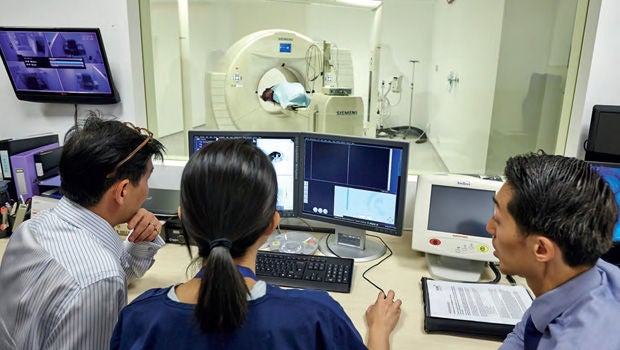
The medical team monitoring the results as the patient is being scanned. Photos: Justin Loh
Clinical trials are underway on a new scan that can detect the cause of a certain type of hypertension, making it potentially curable.
For years, Mr Lim In Chong’s abnormally high blood pressure levels kept him on tenterhooks. Diagnosed with hypertension since he was 21 years old, Mr Lim, now 43, has been taking pills for the last two decades to keep his condition in check.
His greatest fear is getting a stroke, and he has every reason to fear this. Hypertension affects one in four adults in Singapore, and accounts for almost half the deaths from cardiovascular disease.
Recently, Mr Lim was given a new scan — the 11C-Metomidate PET/CT — as part of a 25-patient clinical trial conducted by Changi General Hospital (CGH), together with the Clinical Imaging Research Centre (CIRC) at the National University of Singapore’s Yong Loo Lin School of Medicine.
The scan, which is only available in the clinical trial, pinned down the cause of his hypertension, paving the way for a potential cure.
Why it’s curable
While there is no cure yet for most types of hypertension, Mr Lim’s type — primary aldosteronism — is different, because it is possible to cure if the cause can be found.
The condition occurs when tiny benign growths found in one or both adrenal glands (located above the kidneys) produce too much aldosterone, a steroid hormone that regulates blood pressure, said Adjunct Assistant Professor Troy Puar, Consultant Endocrinologist, CGH, who is leading this multicentre trial.
Too much of aldosterone causes salt retention in the body, which drives hypertension. About 5 per cent of people with hypertension have high levels of this hormone.
When the adrenal gland that is overproducing this hormone is removed through surgery, the associated hypertension may disappear, too.
The source of the excessive aldosterone can be detected using the new scan. This non-invasive scan is done by injecting a radioactive tracer into the patient to light up problem areas. It takes less than an hour to do, emits less radiation than a conventional CT scan, and is able to detect small growths and excessive aldosterone in the adrenals more accurately than the existing test, said Dr Puar.
The existing test, adrenal vein sampling, is done under local anaesthesia by inserting a catheter through a vein from the patient’s groin to draw blood samples. Usually, patients have to stay overnight in hospital.
But the adrenal vein sampling test does not always produce conclusive results. “In many centres, up to 50 per cent of procedures are unsuccessful and hence inconclusive. Fortunately, CGH has had a 100 per cent success rate over the last five years,” said Dr Puar.
Living with one gland
If only one gland is abnormal, the patient may proceed with surgery to remove the abnormal gland, which would halt the excessive hormone production and potentially cure the hypertension. Surgery is not possible if both glands are affected.
“We offer surgery if only one gland is affected, because the adrenals are necessary for producing cortisol, an important steroid needed for life. With the other adrenal gland remaining, a patient can live a normal life,” said Dr Puar.
He added that some patients prefer to take medication for life instead of surgery, but others want surgery when they find that it may cure their hypertension once and for all. However, some may still have hypertension after the surgery because of other contributing factors and would still need medication, but usually at a lower dose.
“Generally, the less medicine the patient takes, the better, as each has its potential risks and side effects,” said Dr Puar.
Mr Lim opted for surgery to remove his abnormal adrenal gland. “I’ve been on medication for more than 20 years, but it was just masking and not fixing the problem. With surgery, I hope my hypertension can be cured. At the very least, I hope to improve my condition and take less medication,” he said.













 Get it on Google Play
Get it on Google Play